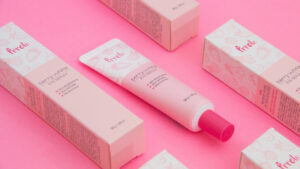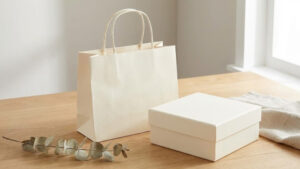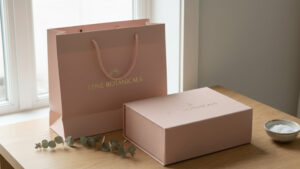Last Updated on June 30, 2025 by Packoi Team
If you analyze the buying behavior of your customers, you’ll observe that a buyer’s first impression of your product is formed the moment they see the packaging. So if they’re impressed by the print and design of your retail paper bag, that could help increase your sales.
In this article, you’ll discover the different printing techniques that you can use to create custom shopping bags. You’ll also get tips to help you choose the right printing method that’ll give you the type of custom bags that’ll represent your brand the best.
10 Different Printing Options for Custom-Printed Bags
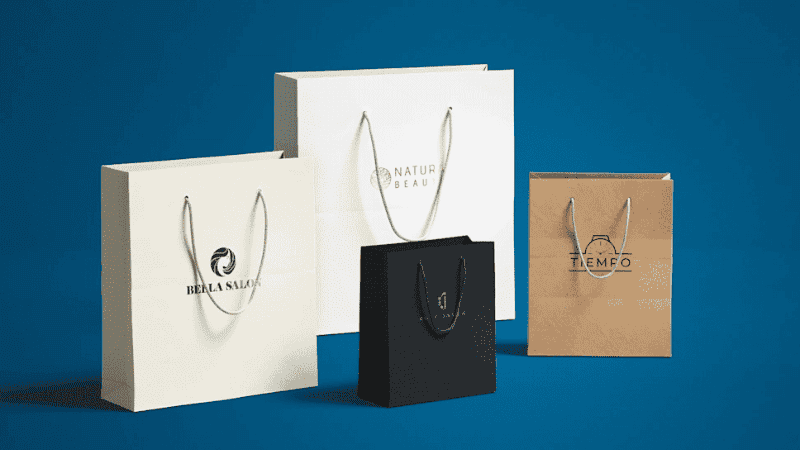
Imagine if your shopping bags had visually appealing designs and prints. How would that affect the customer’s perception of the products inside the bag?
If a person passing by a retail store sees customers coming out with high-quality, well-designed paper bags, they’ll feel intrigued. If you impress them enough with the retail bag design, they might be enticed to enter the store as well.
This is why you need to choose the right printing option for your retail bags. To help with this crucial decision, here are 10 printing options typically used to print on retail bags.
Screen Printing
Screen printing is considered one of the traditional ways of printing on various types of materials. Also known as silkscreen printing, this involves the pressing of ink through a stenciled mesh screen so the design appears on the surface of the retail bag.
This is best for fabric, but it can also be applied to other materials for custom-printed bags, like paper bags. The way the ink is pressed onto the bag gives it a finish that won’t wear off easily.
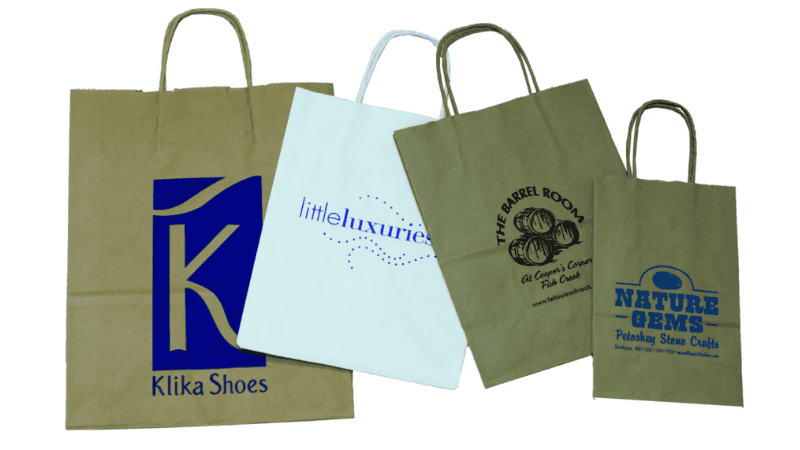
If you want vivid colors for your printed bag design, this is a great printing option to use. It’s cost-efficient because you can reuse the stenciled screen multiple times. However, it’s only ideal for simple designs with no more than four colors. As each color is pressed onto the flat surface of the bag one by one, having too many colors would leave you with a very thick print.
Digital Printing
Digital printing involves the direct transfer of artwork onto the surface of your custom shopping bags. Unlike screen printing, this doesn’t require the use of plates or screens. Instead, it uses inkjet technology, which allows intricate designs to be printed on any surface. This means it’s easier to produce vibrant designs with sharp details and colors, regardless of how many colors there are.
To use this printing method, you need a PDF copy of the image. This is a quick way to get printed shopping bags and is best for small quantities. You can also have this printed on curved surfaces, so feel free to be unique with the shape of your retail bags.
CMYK Printing
This is a method that adapts the screen printing technique, but it can be applied to intricate graphics for custom-printed bags. It uses four types of ink: cyan, magenta, yellow, and black. These are mixed in different intensities that can copy exact Pantone shades. This allows for complex designs like photo-realistic or gradient images to be printed on shopping bags.
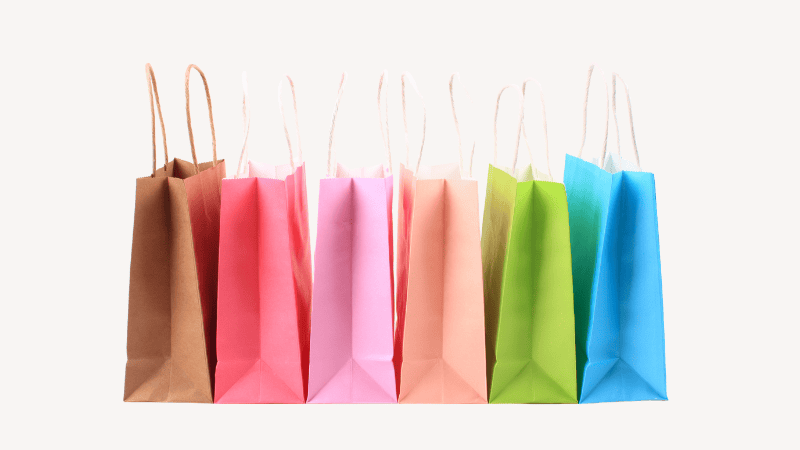
This is the ideal printing option if you have a detailed design for your paper bag. It’s also easier to achieve the exact brand colors that tie up your retail bags with the rest of your packaging designs. Like digital printing, you can apply this to both flat and curved surfaces.
Transfer Printing
This type of printing method initially prints the design on a substrate. Then, that material is pressed onto the bag, where heat and pressure are used to transfer the design onto the bag’s surface. This is why it’s called transfer printing. You move it from one substrate to another.
This printing technique will allow you to capture intense colors and designs with a high-quality finish. Even if you only have a small design, it can easily be captured by this printing method.
Rotary Printing
This printing technique is another version of screen printing. This time, it uses cylindrical screens attached to a machine. This is used to ink the design onto the surface of the bag.
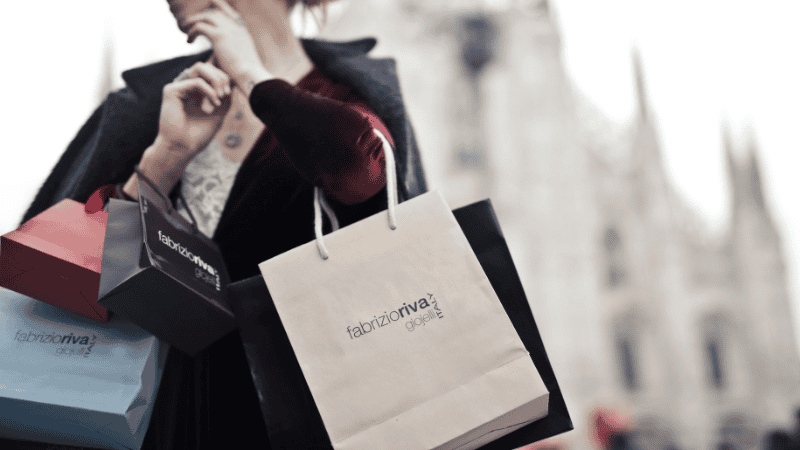
This is a great choice if you’re going to mass-produce custom-printed bags. It’s cost-efficient for huge volumes and can maintain a consistent quality of print. It also has a quick turnaround. So if your need for new retail bags is constrained by time, this is a great option for you to use.
Litho Printing
Another way to refer to this printing option is offset printing. It involves the transfer of ink from a plate to rubber rollers, and then to the surface of the custom shopping bags. The design is laser-engraved onto an aluminum plate and can be reused multiple times. This is the best option if you have detailed designs and require precise colors for the output. It’s also a cost-efficient option for huge quantities of bags.
This is a printing style that high-scale brands would use to ensure that the exact Pantone and design of their branding are applied. It requires great skill to perfect the mixing of the ink, so make sure you’re choosing the right printing supplier.
Cold Foil Printing
This is a good choice for luxury retail bags. It involves the use of metallic foil to apply the design to a bag. The process involves the adhesive application of cold foil on a press sheet. This happens before printing, so different designs and colors can be overprinted inline. You can use the CMYK colors to change the shades you’ll apply to the custom-printed bags.
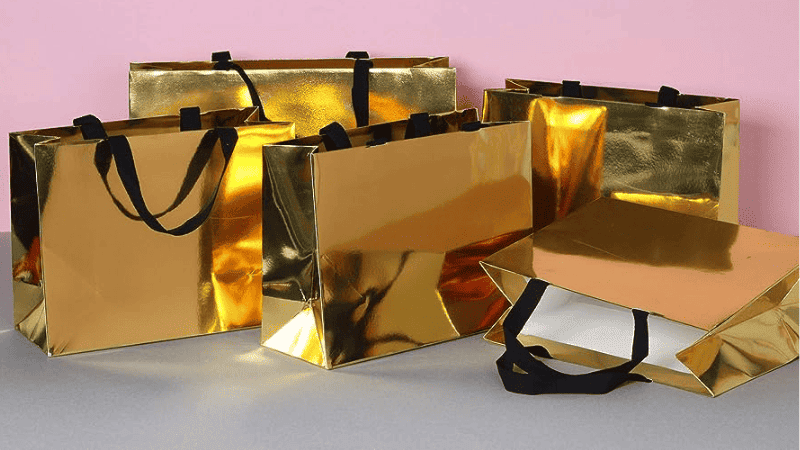
Hot Stamping
This option also uses foil material to print the design on retail bags. But instead of using adhesive, heat and pressure are used to bond the foil to the bag. The heat means this technique doesn’t apply to custom-printed plastic bags. You can only use it for paper or fabric bags.
This is a great option for special events because the metallic finish of the design will give shopping bags a luxurious look. While it makes the bag look opulent, it also limits you to using only one color for the design of the bag. Since it’s metallic, it’s usually enough to have just one color in your design.
Flexographic Printing
This custom printing option is a great method for straightforward designs that require bold applications. It uses a flexible relief printing plate to transfer the ink onto the bag’s material. It’s similar to lithographic printing. However, this has a more direct process of application, but it won’t produce the same detailed color design as litho printing.
The benefit of this printing method is that it can run large quantities faster and in a more cost-efficient manner.
Glitter Printing
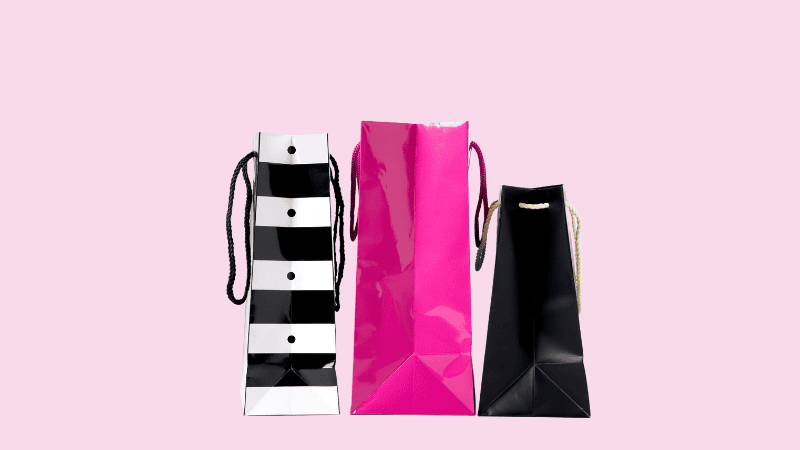
This type of printing is quite special. It involves a process of infusing ink with glitter particles. When it’s applied to the surface of the bag, it adds a sparkle to the design. It’s a great choice if you want to make eye-catching retail bags.
Glitter print on custom shopping bags can easily make them stand out. It’s even a good candidate to be reused as gift bags by your customers. The texture will also make it feel luxurious and opulent, elevating the perceived value of your brand and products.
This is a great method for special occasions, holiday gift-giving events, etc.
Tips to Choose the Right Printing Method for Retail Bags
Now that you know the printing options that you can use for your custom-printed shopping bag, how can you choose the right one? There are a couple of considerations.
First of all, you have to consider your brand’s image. Remember, your packaging will represent and advertise your brand and products. If you want to portray your brand as luxurious, your printing style should give your bag an opulent feel. If you want to be deemed a trustworthy brand, choose a design that exudes high-quality packaging.
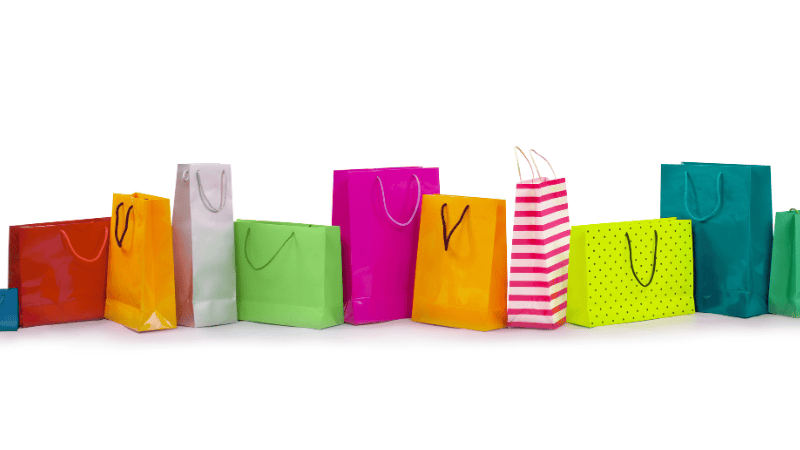
Second, consider the materials. Paper bag materials can use all the printing types mentioned above. Plastic bags, on the other hand, can’t use the printing methods that use heat and pressure.
Third, the complexity of the design should be considered. If you need intricate designs printed, you can’t use silkscreen printing. You have to use digital or transfer print as your options.
Fourth, the quantity and budget will come into play as well. There are printing techniques that are ideal for large quantities. Others are best for smaller quantities because of their cost-efficiency.
Lastly, the bag size and the print area are also things to consider. Make sure your printing technique can give the design specifications that you envisioned for your shopping bags.
FAQs
Which printing method is best for the mass production of custom bags?
Rotary printing and flexographic printing are excellent choices for mass production due to their cost-efficiency and ability to maintain consistent print quality at high volumes.
What is the main benefit of litho printing for retail bags?
Litho printing (offset printing) provides highly detailed designs with precise color matching, making it cost-efficient for large quantities and ideal for high-scale branding.
Can glitter printing be applied to any custom bag?
Glitter printing infuses ink with glitter particles to add sparkle and texture, making bags eye-catching and luxurious, particularly for special events or gift bags.
Conclusion
The impression your retail bags make is a powerful extension of your brand, influencing customer perception and even driving sales. By understanding the diverse range of printing techniques available—from the bold simplicity of screen printing to the intricate detail of digital and litho, and the luxury of foil applications. You can strategically select a method that perfectly embodies your brand’s identity.
Discuss Your Printing Options with Packoi Printing
As you work on the design of your merchandise bags, it’s best to do your research about the printing options as well. Each of the options has its pros and cons. Consider your design, brand elements, products, and customer preferences as you decide on the best printing technique to use.
If you need help, it’s best to talk to an expert about your customization options. Packoi Printing is here to help you understand your options. We’ll guide you in deciding the best printing option that’ll produce the specific retail bag that you want to use.
Give us a call so we can talk about your packaging requirements. We’ll get back to you with a fair quote soon.


